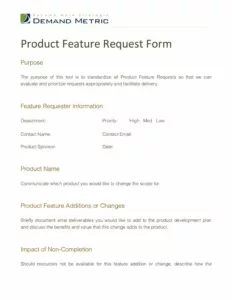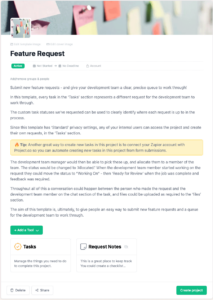Utilizing such a structure offers several advantages. It streamlines communication, reducing response time and improving efficiency. It helps manage expectations by providing a clear roadmap for how requests are processed. Consistency in responses builds trust and reinforces a professional image. Furthermore, a structured approach enables better tracking and analysis of incoming requests, facilitating informed product development decisions.
The following sections delve into the core components of a well-defined structure, exploring best practices for creation and implementation, and illustrating the impact of standardized communication on product development and customer satisfaction.
Key Components
Effective structures for handling product enhancement suggestions typically incorporate several crucial elements to ensure clarity, consistency, and efficiency.
1: Acknowledgment: Immediate confirmation of receipt assures submitters their input is valued. This typically includes a unique identification number for tracking purposes.
2: Request Summary: A concise restatement of the suggested enhancement ensures accurate understanding and shared context between the submitter and the development team.
3: Categorization: Assigning requests to specific categories (e.g., feature enhancement, bug fix, usability improvement) facilitates organization and prioritization.
4: Priority Assessment: Evaluation of the request’s importance based on factors such as potential impact, feasibility, and alignment with product strategy. This often involves assigning a priority level (e.g., high, medium, low).
5: Projected Timeline: Providing an estimated timeframe for implementation, even if tentative, manages expectations and offers transparency.
6: Status Updates: Regular communication regarding the request’s progress keeps submitters informed and engaged throughout the process.
7: Rationale for Decisions: Explaining the reasoning behind decisions regarding prioritization and implementation builds trust and fosters understanding, especially for requests that are deferred or declined.
8. Closing: Final communication indicating completion of the request (implemented, declined, or postponed). Declined requests are often paired with a clear rationale.
These components contribute to a streamlined workflow for handling product enhancement suggestions, enabling effective communication and facilitating informed decision-making. A well-structured approach ensures requests are handled efficiently and professionally, promoting satisfaction and transparency.
How to Create a Feature Request Response Template
Creating a standardized response structure for feature requests involves careful consideration of key elements to ensure clarity, consistency, and efficiency in communication.
1: Define Objectives: Clarify the purpose of the template and the intended audience. Determine the information required to effectively process and manage incoming requests.
2: Structure the Template: Establish a clear format with designated sections for each key component (acknowledgment, summary, categorization, priority, timeline, updates, rationale, and closing).
3: Craft Standard Language: Develop concise and professional phrasing for each section. Maintain a neutral tone and avoid technical jargon where possible.
4: Incorporate Placeholder Variables: Utilize placeholders for information that will vary per request (e.g., request ID, submitter name, feature description). This allows for easy personalization while maintaining a consistent structure.
5: Establish a Workflow: Integrate the template into the existing workflow for handling feature requests. Define roles and responsibilities for each stage of the process (e.g., receiving, reviewing, prioritizing, implementing).
6: Train Personnel: Ensure all relevant personnel are trained on how to use the template effectively. This includes understanding the purpose of each section and the process for handling requests.
7: Test and Refine: Implement the template in a pilot phase to identify any areas for improvement. Gather feedback from users and stakeholders to optimize the template’s effectiveness.
8: Document and Maintain: Document the template’s structure, usage guidelines, and any updates made. Regularly review and update the template to ensure it remains aligned with evolving needs and best practices.
A well-defined structure streamlines communication, manages expectations, and facilitates efficient handling of incoming requests, ultimately contributing to improved product development and customer satisfaction.
Standardized response structures provide a crucial framework for managing incoming suggestions for product enhancements, ensuring consistent communication, efficient processing, and informed decision-making. Key components, including clear acknowledgment, detailed summaries, categorization, priority assessment, timelines, regular updates, and transparent rationale explanations, contribute to a streamlined workflow. Developing these structures requires careful planning, incorporating placeholder variables for personalization, integrating them into existing workflows, and providing adequate training. Regular review and refinement ensure ongoing effectiveness.
Effective management of incoming requests plays a vital role in product development, fostering collaboration between stakeholders and driving continuous improvement. Organizations prioritizing clear communication and structured processes are better positioned to leverage valuable user feedback, enhance product offerings, and achieve greater customer satisfaction.


